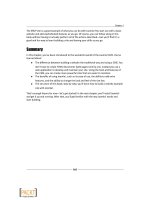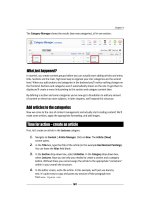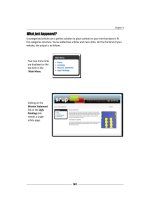Joomla cho người mới bắt đầu part 1 pdf
Bạn đang xem bản rút gọn của tài liệu. Xem và tải ngay bản đầy đủ của tài liệu tại đây (1.64 MB, 10 trang )
1
Introduction: A New and Easy Way to
Build Websites
You want to build a website. It should look great, and it should be easy to use
and maintain. Keeping it up-to-date should be eortless, not a lot of work.
Changing the appearance of your site should take minutes, not hours. You
don't want to manage it all by yourself, but you want to enable other people
to log in and write new content without having to understand HTML or other
coding languages. And when your site grows, it should be easy to extend it
with new funconality—maybe adding a forum, or a newsleer.
If that's what you're looking for, welcome to Joomla!. When it comes to creang a great,
professional looking website that's easy to use, you really can't beat the power of a Content
Management System (CMS) such as Joomla!. Using Joomla!, you don't have to be a web
professional to create a state-of-the-art website. Without wring a single line of code, you
can create any kind of site, featuring a variety of cool and advanced features.
Introducon: A New and Easy Way to Build Websites
[ 8 ]
Join the CMS revolution
Maybe you have some experience building websites the tradional way. That basically meant
creang HTML documents—web pages—one by one. As the site grew, you'd end up with a
bunch of HTML documents, trying to keep all of them organized and making sure all menu
links stayed up-to-date. You'd probably maintain the site by yourself because anyone else
who added content would have to know their way around in the structure of your parcular
site, and be procient in the web eding soware you use.
Enter the Holy Grail of web building: the Content Management System! A CMS is an
applicaon that runs on a web server that allows you to develop and maintain a website
online. It comes packed with tools and features, from basic features to add and modify
content to advanced funconality such as user registraon or site search capability. In
short, a CMS makes it possible to build sites that would normally involve a full team of
web professionals with a massive amount of me, money, and experse at their disposal.
All that magic is made possible because a CMS is really an advanced set of scripts (wrien in
a scripng language, such as PHP) that uses a database to store the content of your website.
From that database, it retrieves bits and pieces of content and presents them as web pages.
This dynamic way of storing and presenng content makes a CMS very exible. Do you want
to show only a selecon of arcles from a specic category on a page? Do you want to display
only the intro texts and images of the most recent arcles on the home page? Do you want
to add a list of links to the most popular contents? Do you want to limit access to registered
users? It's all possible—just pick the right sengs. Addionally, a CMS allows you to integrate
all sorts of extra features, such as contact forms, picture galleries, and much more.
The best part is that CMSes like these are yours to download and deploy today. You can
pick your CMS of choice from a range of freely available open-source products. Your new
CMS-powered site can be online tomorrow. Now how's that for a great deal?
Why would you choose Joomla!?
There are many open-source CMSes around. They're all great tools, each with its own typical
uses and benets. Why would you want to choose Joomla!?
People tend to choose Joomla! because they nd it easy to use. It has a clear and
friendly user interface. It makes it easy to manage content and easy to create
and publish arcles to keep your site current—anyme, anywhere—using a web
browser.
Adding new features takes just a few clicks. There are thousands of extensions
available, from menu systems to commenng systems and forums.
Chapter 1
[ 9 ]
It's very easy to change the site's appearance—templates are abundant and
can be installed within minutes, giving your site a fresh look and feel.
Joomla! is acvely developed and it's well supported by a huge worldwide
community of users and developers. It is updated frequently, adding new
features, security enhancements, and other improvements.
Apart from these typical Joomla! benets, it comes with all of the advantages of a
state-of-the-art CMS. Just a few examples are:
It's really easy to add or edit content and to keep it organized (even if there's lots
of it).
Keeping hyperlinks up-to-date is greatly automated. For example, if you add a new
web page to a category a new link will automacally appear in pages poinng to
that category.
You don't have to maintain the website all by yourself. Other users can add content,
add new menu items, and much more.
The numbers seem to indicate that Joomla! is the open-source CMS of choice for web
builders worldwide. It's the engine behind some 20 million websites worldwide and this
number is sll growing rapidly day by day. Joomla! is one of the biggest open-source
soware projects around, supported by a huge user community and constantly being
developed further by an internaonal team of volunteers.
What kind of sites can you build with Joomla!?
Let's have a look at some great real-world examples of sites built using Joomla!—if you're
anything like me, that's what makes you want to get started right away, creang something
equally cool (or preferably, something even beer!). These are just a few examples from the
Web and from the Joomla! site showcase ( />They are very diverse sites from very dierent organizaons, each with their own goals and
target groups. What they have in common is that they deploy Joomla! in a way that you
could too. They all create a great Web appearance by adapng the CMS to their specic
needs, making it perfectly suited for the content they present and the impression they want
to make.
Introducon: A New and Easy Way to Build Websites
[ 10 ]
Here's an example from a non-prot organizaon: Green Energy Soluons
(). It shows a clean corporate design, displaying
a few highlights from the site's contents combined with simple and clear navigaon.
Chapter 1
[ 11 ]
The following example is a relavely small website of a specialized company
(www.abbeyfloor.co.uk). The site oers a clear and aracve overview of the
services and products. The design is a customizaon of a freely available Joomla! template.
Introducon: A New and Easy Way to Build Websites
[ 12 ]
Of course, Joomla! can handle much more content; complex sites with thousands of pages
are no excepon. Here's an illustraon of a content-rich site with a made-to-measure design,
oering its various target groups dierent ways to reach the site's contents: the University of
Nebraska website ():
Chapter 1
[ 13 ]
One nal example demonstrates that Joomla! sites don't have to look anything like a typical
Joomla! site. If you want to take customizaon to the max, you can use an enrely dierent
design—and sll take advantage of Joomla!'s default funconality to power the site. The
following is a site of a Dutch freelance cook (www.tijskookt.nl):
IIIfff yyyooouuu'''rrreee lllooooookkkiiinnnggg fffooorrr sssooommmeee mmmooorrreee iiinnnssspppiiirrraaaooonnn,,, bbbrrrooowwwssseee ttthhheee oooccciiiaaalll JJJoooooommmlllaaa!!!
ssshhhooowwwcccaaassseee::: hhhttttttppp::://////cccooommmmmmuuunnniiitttyyy jjjoooooommmlllaaa ooorrrggg///ssshhhooowwwcccaaassseee ooorrr gggooo tttooo
wwwwwwwww bbbeeessstttooofffjjjoooooommmlllaaa cccooommm aaannnddd lllooooookkk aaarrrooouuunnnddd ttthhheee BBBeeesssttt ooofff SSSiiittteeesss ssseeecccooonnn
DDDooowwwnnnllloooaaaddd aaattt WWWooowww!!! eeeBBBooooookkk
WWWWWWWWW WWWOOOWWWEEEBBBOOOOOOKKK CCCOOOMMM
Introducon: A New and Easy Way to Build Websites
[ 14 ]
Learning to use Joomla!
It may sound too good to be true. Does Joomla! really make creang state-of-the-art
websites side splingly easy? Let's be honest—it will make it reasonably easy, but of course
it does require you to invest some me and eort. Aer all, working with Joomla! (or any
CMS) is very dierent from building websites the tradional way. You'll noce this as soon as
you start installing the system. Compared to seng up a simple stac website consisng of a
few HTML pages, building a Joomla!-powered site takes a bit more preparaon. You'll need
hosng space that meets specic requirements and you'll need to set up a database. It's very
doable, and this book will run you through the process step by step. But it does take some
commitment and isn't really the most excing part of working with Joomla!
Once you've got Joomla! set up, you'll soon get the hang of creang a ne, basic site.
However, it can be challenging to get things just right for your parcular goals. Aer all, you
don't want "just any Joomla!-powered site"—you want to build a specic site, aimed at your
specic target audience. The Joomla! Beginner's Guide will help you to go beyond a basic site
with default sengs, and it will help you make the choices that t your goals.
One last challenge you should be aware of; in some ways, Joomla! will make it almost too
easy to add any funconality you like. There's nothing to stop you from adding dozens of
extra funcons to your site or stung your pages with eye candy. Of course, that's not really
what makes a good site, nor is it what makes your visitors ck. Customizing a site to your
needs while keeping an eye on user experience is something a CMS can't do for you. But if
you're serious about creang an excellent website that your visitors will want to read and
use, then this book will help you nd your way.
In short, even with Joomla!, it will take a lot of me and eort to create and maintain great
websites. The site won't run itself, but Joomla! will make it much easier and much more fun
for you (and your web team members) to keep it evolving.
What you'll learn using this book
The Joomla! Beginner's Guide is designed to make it as easy as possible for you to get the
most out of Joomla!. It's focused on learning by doing—the structure of the book reects the
process of building a website. First, you'll install Joomla!, take a tour of the system, and get a
feel for what it's like. Aer that, you'll start building your own site step by step:
You master the fundamentals by creang a basic website with lightning speed.
You'll adapt and expand this basic site to meet your (and your visitors') growing needs.
You'll set up a structure for the dierent sorts of content you want on your site, and you
learn how to add dierent types of pages.
Chapter 1
[ 15 ]
You'll learn how make that content easy to nd through well-designed menus and
design an aracve home page that directs people to the content they might be
interested in.
You'll learn how to engage your web visitors and turn them into acve users who
can register and add content.
You'll extend Joomla!'s capabilies and add features (such as a picture gallery) to
the site.
You'll change the site layout and make it more aracve.
You'll nd out how to tweak the site to aract search engine trac and to keep the
site safe.
About the example site
The Joomla! Beginner's Guide focuses on building a realisc example site step-by-step.
Instead of just learning about Joomla!'s capabilies in general terms, you'll meet real-world
web building challenges. Throughout the book, you'll achieve all of your cous client's
goals (that is 'I want a website that my web team members can update themselves' or
'I want a website that makes it easy to navigate through a large amount of content').
Now who's that client of yours? It's the Society for the Reappreciaon of Ugly Painngs,
also known as SRUP. They just love amateur painngs that mostly end up dumped in the
trash heap or turn up in charity shops. You'll have to agree that it's a terrible waste. The
SRUP think that bad painng is good. They argue it's creave, it's the ordinary peoples'
arsc view on reality, and it can be valuable art—in its own, ugly way. The SRUP people
need a website to inform the public about their goals, showing ne examples of ugly
painngs, and encouraging people to join and parcipate.
Introducon: A New and Easy Way to Build Websites
[ 16 ]
You'll take the SRUP site through dierent stages of development. First you'll base the site
on Joomla!'s default design and layout.
Later on, you'll add advanced features and shape the site's contents and design to meet
the changing needs of your client.









